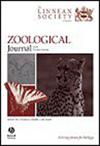英国新侏罗世(早侏罗世)的鲛类鳄形目动物
IF 3
2区 生物学
Q1 ZOOLOGY
引用次数: 0
摘要
在侏罗纪和早白垩世,巨齿鳄是浅海生态系统中无处不在的组成部分。遗憾的是,它们的起源仍然是一个谜。在这里,我们描述了来自英国志留纪(可能是早普利恩巴赫纪)的三个标本:一个部分颅骨喙、一系列颈椎骨和两个背椎骨,并附有基质。这些标本是已知最古老的巨齿龙化石之一,其中的部分颅骨喙是已知最古老的非新齿龙类巨齿龙化石。这部分颅骨喙具有鳄形目中从未见过的独特的喙部特征组合,有助于阐明早期巨齿类内部喙的演化,表明巨齿类副鼻窦的减少与后来分化类群中出现的喙部神经血管的重组或松质骨微结构的增加无关。根据我们的 CT 样本,Eoneustes + Metriorhynchidae 亚支系的颅骨显微结构发生了变化,这种变化与盐腺的增大和外侧眶前窦与副鼻窦的脱钩相吻合。由于没有进行广泛的组织学取样,我们无法确定向强制性水生生活方式的转变是否发生在Metriorhynchidae进化之前。本文章由计算机程序翻译,如有差异,请以英文原文为准。
Thalattosuchian crocodylomorphs from the Sinemurian (Early Jurassic) of the UK
Thalattosuchian crocodylomorphs were a ubiquitous component of shallow marine ecosystems during the Jurassic and Early Cretaceous. Alas, their origins remain a mystery. Here we describe three specimens from the Sinemurian (and possibly Early Pliensbachian) of the UK: a partial cranial rostrum, a series of cervical vertebrae, and two dorsal vertebrae adhered with matrix. These specimens are amongst the oldest known thalattosuchian fossils, with the partial cranial rostrum being the oldest known non-neothalattosuchian thalattosuchian. This partial cranial rostrum has a unique combination of rostral characters never seen before in any crocodylomorph, and helps to elucidate early thalattosuchian internal rostrum evolution, suggesting that the reduction in thalattosuchian paranasal sinuses was not related to either the reorganization of rostral neurovasculature seen in later diverging taxa or the increased cancellous bone microstructure. Based on our CT sample, a shift in cranial bone microstructure occurred in the Eoneustes + Metriorhynchidae subclade, one that coincided with the enlargement of the salt glands and decoupling of the external antorbital fenestra from the paranasal sinuses. Without extensive histological sampling we cannot determine whether the shift to an obligate aquatic lifestyle occurred prior to the evolution of Metriorhynchidae.
求助全文
通过发布文献求助,成功后即可免费获取论文全文。
去求助
来源期刊
CiteScore
6.50
自引率
10.70%
发文量
116
审稿时长
6-12 weeks
期刊介绍:
The Zoological Journal of the Linnean Society publishes papers on systematic and evolutionary zoology and comparative, functional and other studies where relevant to these areas. Studies of extinct as well as living animals are included. Reviews are also published; these may be invited by the Editorial Board, but uninvited reviews may also be considered. The Zoological Journal also has a wide circulation amongst zoologists and although narrowly specialized papers are not excluded, potential authors should bear that readership in mind.

 求助内容:
求助内容: 应助结果提醒方式:
应助结果提醒方式:


